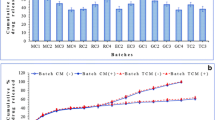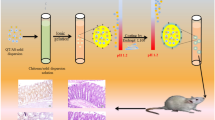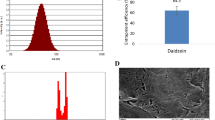Abstract
COX-2 inhibitors have demonstrated beneficial effects in colorectal cancer. The purpose of this study was to prepare and evaluate the colon specific microspheres of COX-2 inhibitors using valdecoxib as a model drug. Mucoadhesive core microspheres were prepared using chitosan as polymer and entrapped within Eudragit S 100 for colon targeting. FTIR spectrum of selected, coated microspheres showed peaks of valdecoxib at 3377, 3250, 1334 and 1155 cm−1. XRD showed amorphous character and DSC showed depressed broad endotherm of valdecoxib at 169.07°C, which may be attributed to dilution effect by the amorphous polymer. The coated microspheres were spherical with an average size of 90 μm. Storage of the microspheres at 40°C/75% relative humidity for 6 months indicated no significant drug degradation. The coated microspheres did neither release the drug in acidic pH of stomach (pH 1.2) nor in small intestinal pH between 5 to 6.8, and the release started at pH 7.4, indicting perfect colonic delivery. The coated microspheres pretreated with phosphate buffer pH 7.4 for 30 min, when applied to mucosal surface of freshly excised goat colon, showed good mucoadhesion. The drug release at pH 7.4 and good mucoadhesive property of the microspheres make the system ideal for colonic delivery.






Similar content being viewed by others

References
Tattersal MHN, Thomas H. Recent advances: oncology. Br Med J. 2005;318:445–8.
Pisani P, Bray F, Parkin DM. Estimates of the world wide prevalence of cancer for 25 sites in the adult population. Int J Cancer. 2002;97:72–81.
Kune S, Kune GA, Watson LF. The Melbourne Colorectal Cancer Study: incidence findings by age, sex, site, migrants and religion. Int J Epidemiol. 1986;15:483–93.
Kune GA, Kune S, Watson LF. Colorectal cancer risk, chronic illnesses, operations, and medications: case control results from the Melbourne Colorectal Cancer Study. Cancer Res. 1988;48:4399–404.
Giovannucci E, Rimm EB, Stampfer MJ, Colditz GA, Ascherio A, Willett WC. Aspirin use and the risk for colorectal cancer and adenoma in male health professionals. Ann Intern Med. 1994;121:241–6.
Thun MJ, Namboodiri MM, Health CW Jr. Aspirin use and reduced risk of fatal colon cancer. N Eng J Med. 1991;325:1593–6.
Craven PA, Thornburg K, DeRubertis FR. Sustained increase in the proliferation of rat colonic mucosa during chronic treatment with aspirin. Gastroenterology. 1988;94:567–75.
Thun MJ, Henley SJ, Patrono C. Non steroidal anti inflammatory drugs as anticancer agents: mechanistic, pharmacologic and clinical issues. J Nat Cancer Inst. 2002;94:252–66.
Chan TA. Non steroidal anti inflammatory drugs, apoptosis and colon cancer chemoprevention. Lancet Oncol. 2002;3:166–74.
Finckh A, Aronson MD. Cardiovascular risks of cyclooxygenase-2 inhibitors: where we stand now. Ann Internal Med. 2005;142:212–4.
Bartalsky A. Salicylazobenzoic acid in ulcerative colitis. Lancet. 1982;319:960–4.
Riley SA, Turnberg LA. Sulphasalazine and aminosalicylate in the treatment of inflammatory bowl disease. Q J Med. 1990;75:561–2.
Gazzaniga A, Iamartina P, Maffione G, Sangal ME. Oral delayed release system for colonic specific delivery. Int J Pharm. 1994;108:77–83.
Ashford M, Fell J, Attwood D, Sharma H, Woodhead P. In vitro investigation into the suitability of pH dependent polymer for colonic targeting. Int J Pharm. 1993;95:193–9.
Hori M, Onishi H, Machida Y. Evaluation of Eudragit-coated chitosan microparticles as an oral immune delivery system. Int J Pharm. 2005;297:223–4.
Jain D, Panda AK, Majumdar DK. Eudragit S100 entrapped Insulin microspheres for oral delivery. AAPS Pharm Sci Tech. 2005;06:E100–7.
Marvola M, Nykanen P, Rautio S, Isonen N, Autere AM. Enteric polymer as binder and coating material in multiple unit site-specific drug delivery system. Eur J Pharm Sci. 1999;7:259–67.
Rahman Z, Kohli K, Khar RK, Ali M, Charoo NA, Shamsher AA. Characterization of 5-fluorouracil microspheres for colonic delivery. AAPS Pharm Sci Tech. 2006;7(2):E1–9.
Chourasia MK, Jain SK. Pharmaceutical approaches to colon targeted drug delivery systems. J Pharm Pharm Sci. 2003;6:33–66.
Fatima A, Asghar L, Chandran S. Multiparticulate formulation approach to colon specific drug delivery: current perspectives. J Pharm Pharm Sci. 2006;9(3):327–38.
Kramer A, Turk S, Vrecer F. Statistical optimization of diclofenac sodium sustained release pellets coated with polymethacrylic films. Int J Pharm. 2003;256:43–52.
Meyer JH, Dressman J, Fink AS, Amidon G. Effect of size and density on gastric emptying of indigestible solids. Gastroenterology. 1985;89:805–13.
Rodriguez M, Vila-Jato JL, Torres D. Design of a new multiparticulate system for potential site-specific and controlled drug delivery to the colonic region. J Control Release. 1998;55:67–77.
Rathbone MJ, Hadgraft J, Roberts MS. Modified release drug delivery technology. New York: Marcel Dekker Inc.; 2003.
Lehr CM, Bowstra JA, Tukker JJ, Junginger HE. Intestinal transit of bioadhesive microspheres in an in situ loop in the rat. J Control Release. 1990;13:51–62.
ICH Harmonised Tripartite Guideline for Stability Testing of New Drug Substances and Products.
Gibaldi M. Biopharmaceutics & clinical pharmacokinetics. 3rd ed. Phidelphia: Lea Febiger; 1984.
Wagner JG. Interpretation of percent dissolved-time plots derived from in vitro testing of conventional tablets and capsules. J Pharm Sci. 1969;58:1253–7.
Higuchi T. Mechanism of sustained action medication. J Pharm Sci. 1963;52:1145–9.
Hixson AW, Crowell JH. Dependence of reaction velocity upon surface and agitation: I—Theoretical considerations. Ind Eng Chem. 1931;23:923–31.
Bourne DW. Pharmacokinetics. In: Banker GS, Rhodes CT, editors. Modern pharmaceutics. 4th ed. New York: Marcel Dekker Inc.; 2002. p. 67–92.
Chuch HR, Zia H, Rhodes CP. Optimization of sotalol floating and bioadhesive extended release tablet formulations. Drug Dev Ind Pharm. 1995;21:1725–47.
Peppas NA. Analysis of fickian and non-fickian drug release from polymers. Pharm Acta Helv. 1985;60:110–1.
Akbuga J. Preparation and evaluation of controlled release of furosemide microspheres by spherical crystallization. Int J Pharm. 1989;53:99–105.
Jain D, Panda AK, Majumdar DK. Insulin loaded Eudragit S100 microspheres for oral delivery: preliminary in vitro studies. J Biomed Appl. 2006;21:195–211.
Peppas NA, Burim PA. Surface, interfacial and molecular aspects of polymer bioadhesion on soft tissues. J Control Release. 1985;2:257–75.
Sogias IA, Williams AC, Khutoryanskiy VV. Why is chitosan mucoadhesive. Biomacromol. 2008;9:1837–42.
Author information
Authors and Affiliations
Corresponding author
Rights and permissions
About this article
Cite this article
Thakral, N.K., Ray, A.R. & Majumdar, D.K. Eudragit S-100 entrapped chitosan microspheres of valdecoxib for colon cancer. J Mater Sci: Mater Med 21, 2691–2699 (2010). https://doi.org/10.1007/s10856-010-4109-2
Received:
Accepted:
Published:
Issue Date:
DOI: https://doi.org/10.1007/s10856-010-4109-2



